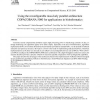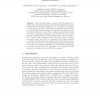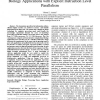11 search results - page 1 / 3 » Using the reconfigurable massively parallel architecture COP... |
PROCEDIA
2010
12 years 11 months ago
2010
Currently several computational problems require high processing power to handle huge amounts of data, although underlying core algorithms appear to be rather simple. Especially i...
TC
2008
13 years 4 months ago
2008
Cryptanalysis of ciphers usually involves massive computations. The security parameters of cryptographic algorithms are commonly chosen so that attacks are infeasible with availabl...
ICCS
2009
Springer
13 years 11 months ago
2009
Springer
Abstract. Today’s general purpose computers lack in meeting the requirements on computing performance for standard applications in bioinformatics like DNA sequence alignment, err...
ISCAPDCS
2007
13 years 6 months ago
2007
—The tremendous growth in the information culture, efficient digital searches are needed to extract and identify information from huge data. The notion that evolution in silicon ...
DATE
2006
IEEE
13 years 10 months ago
2006
IEEE
Temporal partitioning techniques are useful to implement large and complex applications, which can be split into partitions in FPGA devices. In order to minimize resources, each o...



